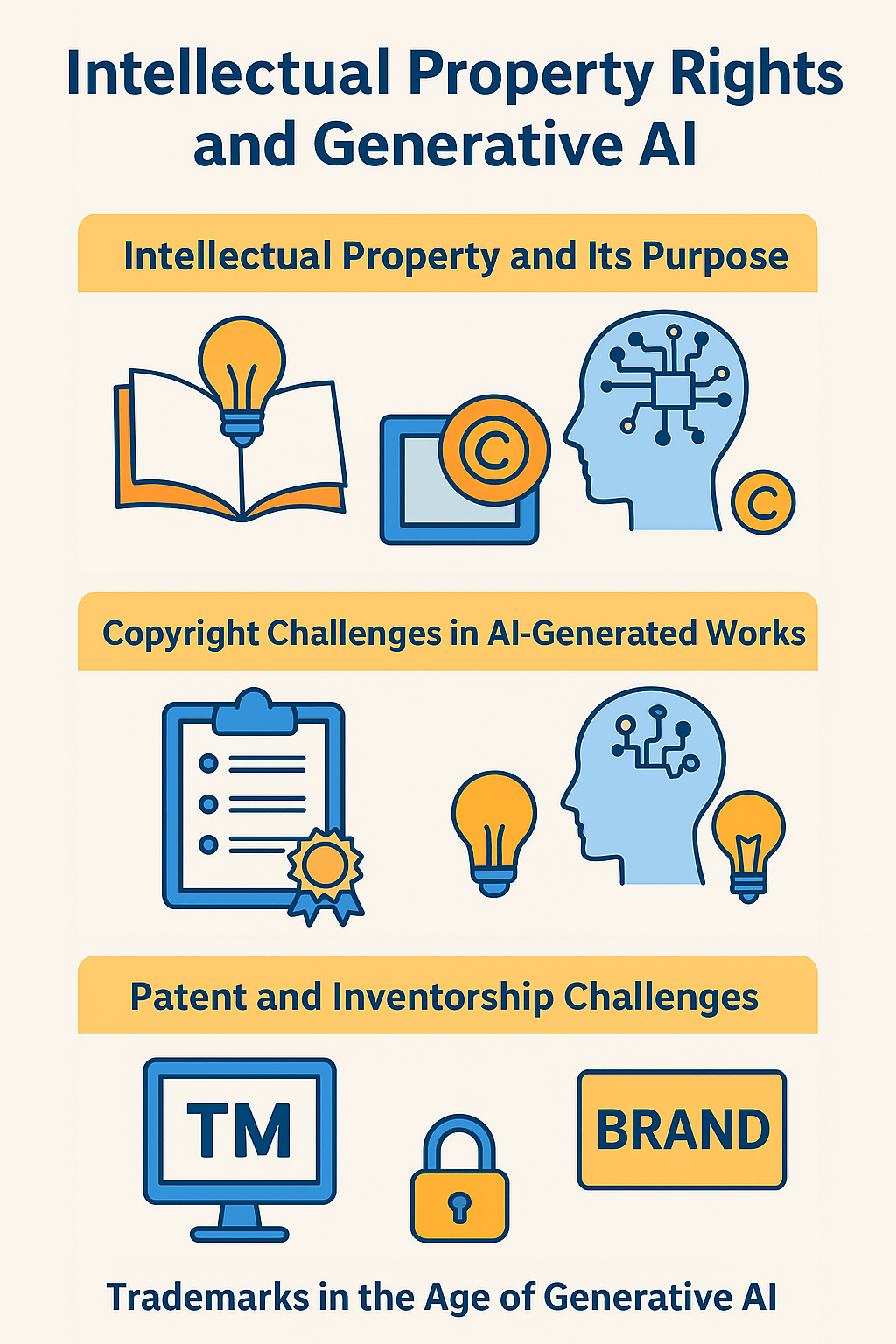View News
Intellectual Property Rights and Generative AI

Intellectual Property Rights and Generative AI
Introduction
The advent of generative artificial intelligence (AI) has revolutionized the way humans create, consume, and preserve creative works. Tools such as ChatGPT, DALL·E, and MidJourney are blurring the line between human and machine creativity—spanning applications from automated software coding to AI-generated literature, music, and visual art. While these technologies stimulate innovation and expand creative possibilities, they also raise complex legal and ethical challenges under the domain of Intellectual Property Rights (IPR).
The central question is: Who owns the rights to AI-generated works, and how should existing laws adapt to this new paradigm?
Intellectual Property and Its Purpose
Intellectual Property Rights are designed to protect and incentivize creativity and innovation. They safeguard literary works, inventions, artistic creations, industrial designs, and brand identities, granting exclusive rights to creators while balancing public access to knowledge.
However, the traditional IPR framework is inherently human-centric—built on the presumption that authorship and inventorship belong to natural persons. With generative AI actively contributing to, and in some cases autonomously producing, new works, this foundation is being fundamentally challenged.
Copyright Challenges in AI-Generated Works
Copyright law protects “original works of authorship” fixed in a tangible medium, as codified under international conventions like the Berne Convention. AI-generated outputs test the boundaries of this principle. Key issues include:
-
AI as Author
Most jurisdictions—including the United States—do not recognize AI as an author. The U.S. Copyright Officeexplicitly states that copyright protection requires human creative input; works created solely by AI are not eligible. -
Human + AI Collaboration
Copyright may subsist where a human’s creative input substantially shapes the AI’s output. For example, if an artist uses AI as a tool (similar to Photoshop), the resulting work may be protected, with authorship attributed to the human operator. -
Risk of Infringement
Since generative AI systems are trained on massive datasets, often scraped from the internet, they may inadvertently replicate copyrighted works. This has triggered lawsuits by authors, photographers, and visual artists (notably in 2023–2024) against AI companies for alleged unauthorized use of their content.
Patent and Inventorship Challenges
Patents reward inventive and novel technical solutions. AI’s ability to design molecules, create prototypes, and generate innovative solutions raises pressing questions:
-
Global Legal Stance
Courts and patent offices across the US, UK, and EU have rejected applications naming AI systems (such as in the DABUS cases) as inventors, affirming that inventorship requires a natural person. -
Practical Dilemma
Even if AI produces inventive outputs, patent law mandates human attribution. This leads to ambiguity: Should credit go to the AI’s developer, the operator who prompted it, or should such works fall outside patent protection entirely?
Trademarks in the Age of Generative AI
Generative AI can instantly produce logos, slogans, and brand names, raising trademark concerns:
-
Similarity Risks: AI-generated marks may unintentionally resemble existing registered trademarks, leading to disputes and infringement claims.
-
Authenticity and Misuse: AI can be exploited to create counterfeit branding or deepfake endorsements, posing significant threats to consumer trust and brand integrity.
Ethical and Policy Considerations
Beyond strict legal questions, generative AI raises broader policy and ethical dilemmas:
-
Fair Compensation for Creators: Should artists and writers whose works are included in AI training datasets be credited or compensated through royalties?
-
Balancing Access and Protection: How can laws ensure widespread access to AI innovation without discouraging original human creativity?
-
Global Harmonization: With IPR rules varying across jurisdictions, inconsistent approaches may lead to forum shopping and legal uncertainty.
Future Directions and Possible Solutions
To adapt IPR frameworks to the realities of generative AI, several strategies are under discussion:
-
Hybrid Authorship Models
Recognizing co-authorship or joint inventorship where substantial human input exists alongside AI involvement. -
Sui Generis Rights
Legislatures may consider creating a new category of protection specifically for AI-generated works, separate from traditional copyright or patent systems. -
Dataset Transparency
Mandating disclosure of training datasets to ensure compliance with copyright and ethical standards. -
Collective Licensing Mechanisms
Establishing frameworks similar to music licensing, where rights holders are compensated for the inclusion of their works in AI training. -
Ethical AI Guidelines
Encouraging responsible innovation by integrating ethical standards that protect human creativity while leveraging AI’s potential.
Conclusion
Generative AI is reshaping the intellectual property landscape in unprecedented ways. While current legal frameworks provide partial guidance, they remain rooted in a human-centric view of creativity and inventorship. The future of IPR must evolve toward a forward-looking framework that:
-
Protects and incentivizes human creators,
-
Recognizes the collaborative role of AI,
-
Ensures transparency and fairness in dataset use, and
-
Encourages ethical, innovative, and globally harmonized solutions.
Ultimately, the goal is to strike a delicate balance between innovation and protection, ensuring that intellectual property laws remain relevant and robust in the age of generative AI.
"Unlock the Potential of Legal Expertise with LegalMantra.net - Your Trusted Legal Consultancy Partner”
Disclaimer: Every effort has been made to avoid errors or omissions in this material in spite of this, errors may creep in. Any mistake, error or discrepancy noted may be brought to our notice which shall be taken care of in the next edition In no event the author shall be liable for any direct indirect, special or incidental damage resulting from or arising out of or in connection with the use of this information Many sources have been considered including Newspapers, Journals, Bare Acts, Case Materials , Charted Secretary, Research Papers etc
Prerna Yadav
LegalMantra.net

